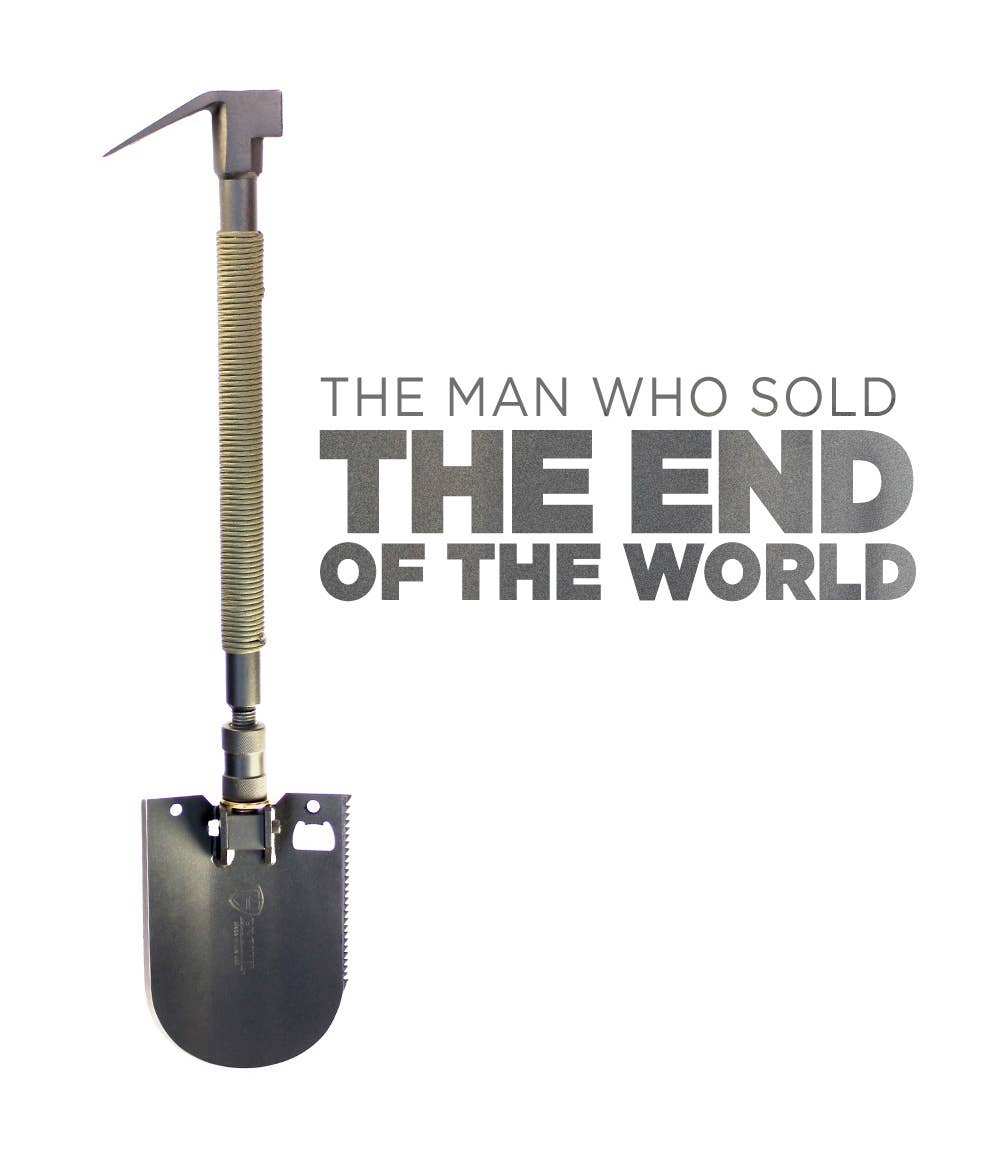
Somewhere in Arizona, a man I have known for less than 24 hours is teaching me how to kill a human being with a shovel. Or, should I say, a special customized shovel whose left edge is an axe blade. “Keep it straight at the target, bring it right to this point, and then” — the device, 26 inches long, goes hurling toward a tree stump, the blade spinning end over end — “straight through.”
That’s Tim Ralston, 49, apocalypse salesman of the year. Before he put a shotgun in the trunk of my car, blindfolded me, and took me to this undisclosed location two-plus hours from Phoenix, he invented the tool we’re throwing. This one product has helped him make more than a million dollars in 2012 selling to people who think America — or the entire world — is at risk of collapse.
The Crovel ($109.99) was conceived as a survival tool for the mashup age, a Swiss Army cudgel that could make Switzerland seem fearsome: half-crowbar, half-shovel, all testosterone. But as the device has gotten more profitable, it has also gotten more violent. There are now 11 other tools packed in there: axe and saw blades on opposite sides of the shovelhead, a hammer, “zombie spikes,” the usual. What began as a utility is now a weapon.
This is what Ralston’s customers demand. They don’t just want a shovel with a crowbar, they want a shovel that can kill somebody. He sells to “preppers” — people preparing for The End of the World As We Know It (T.E.O.T.W.A.W.K.I. in prepper parlance). Preppers have two defining characteristics: They’re afraid, and they’re doing something about it. It’s a subculture that’s rapidly entering the mainstream, emblematic of a country casting about for its role in an age where the United States is less powerful and more insecure. The Crovel is made of power and security.
Preppers include everyone from paranoid conspiracy theorists to suburban moms; anyone, really, who’s assuaging their nerves by having a backup plan. Those plans almost always take into account what happens if, in the face of disaster, society splinters apart instead of comes together. What happens when the survivors turn desperate; what happens when you have to provide for and defend your family?
I ask Ralston if he’s ever used the Crovel against somebody as a weapon. No, but, “You always have those thoughts,” he says. When he retrieves his hurled Crovel from the tree it’s stuck in, he analyzes where the throw would have struck the body of a hypothetical assailant.
Ralston hasn’t brought me up here just to show off his golden goose. He’s eager to get his next projects launched and has a new invention he wants to show me: the X Caliber ($449.99), a set of 10 adapters that turn a single-shot shotgun (an H&R 12-gauge in this case) into a weapon that can fire 10 different types of bullets — X Calibers, get it? This, Ralston thinks, is his next Crovel.
Ralston asks me to go set up some targets for us to shoot. I grab the beer bottles we drank the night before and walk through the clearing. Ralston is on the other end with a loaded shotgun. There is no one else around for half a mile.
I first met Tim Ralston the way most people meet Tim Ralston — he was trying to sell me something. It was the last day of August, and we were in Las Vegas. We weren’t on the glitzy side of town — we were on the dystopian side that makes you feel like you and that homeless guy under the bridge were the only ones to miss the evacuation order. It was a fitting home for the 2012 Survival Expo.
The Expo was, for lack of a more understated descriptor, an apocalypse convention. How that apocalypse will arrive is up for debate. Some preppers are girding for a foreign attack (“I don’t accept death because some asshat over in Siberia decided that they needed to end the existence of the United States,” one attendee told me), others for a nuclear meltdown a la Fukushima, and yet more for a major climate event. There are, of course, the 2012 believers as well. The Expo’s homepage pictures an asteroid the size of Greenland crashing into a rippling Earth; another page includes a widget counting down the days until the end of the Mayan calendar.
For the most part, though, preppers aren’t Mayan devotees. “I don’t believe in any of that nonsense,” Ralston says, and neither did anyone else I met at the Expo. After Dec. 21 (hopefully) passes without incident, doomsdayers like Ralston will still be here, preparing, waiting.
Ralston’s a handsome dude, with the face of a young Martin Sheen or a lost Baldwin brother, the jawline of an unjowled Jay Leno, and the hair of a not-yet-dejected Mitt Romney. But in prepper circles, Ralston is famous not for his looks but for having shot off his thumb on national TV.
Earlier this year, Ralston made an appearance on Doomsday Preppers, National Geographic Channel’s highest-rated show ever. (In a sign of the times, there appears to be more of an appetite for National Geographic’s coverage of American neurosis than, say, Amazonian bullet ants.)
By the end of his segment, Ralston had blasted a hole through the middle of his thumb with a malfunctioning prototype gun while his kids stood nearby. As the show’s medic wrapped the thumb, Ralston passed out, his eyes rolling back in his head. (“I was resting my eyes,” Ralston says. “Dehydration kicked in. A little shock.”) The bullet cut clean through the middle of his thumb; doctors kept it intact by shortening the finger. Ralston branded the thumb his “midget digit.”
There was another lingering effect of Ralston’s stint on Preppers: It made him rich. On the show, the Crovel is Ralston’s sidekick. “This is the tool that you’re going to need. If there’s an end-of-the-world scenario, this one is going to save your life,” he says. At one point he uses the Crovel to hack open a dead pig hanging from a chain in the backyard. At another, he uses an old Crovel to open the packaging of a new Crovel.
The hard sell worked. Before his episode of Preppers aired, Ralston was selling a few Crovels a day. After? 300–400. He says he still sells hundreds every time there’s a rerun. (The episode has aired no fewer than 15 times to date.) When I met him, he had sold somewhere between $12,000 and $15,000 worth of merchandise at Survival Expo 2012. It was a good weekend.
Overall, he’s made more than a million dollars in online sales since the episode first aired. And this fortune has largely been amassed by targeting preppers, who believe their own dream is increasingly out of reach or under attack — the people for whom the world (or at least the world as it was) is, in many ways, already in the process of ending. Meanwhile, Ralston is just getting started.
“I already know my endgame is to sell the Crovel brand to a very large entity,” Ralston told me at the end of the convention. Doesn’t he feel too close to his baby, which has brought him so much success, to turn around and sell it? “Heck no. That’s an inventor’s mentality. I’m a businessman.”
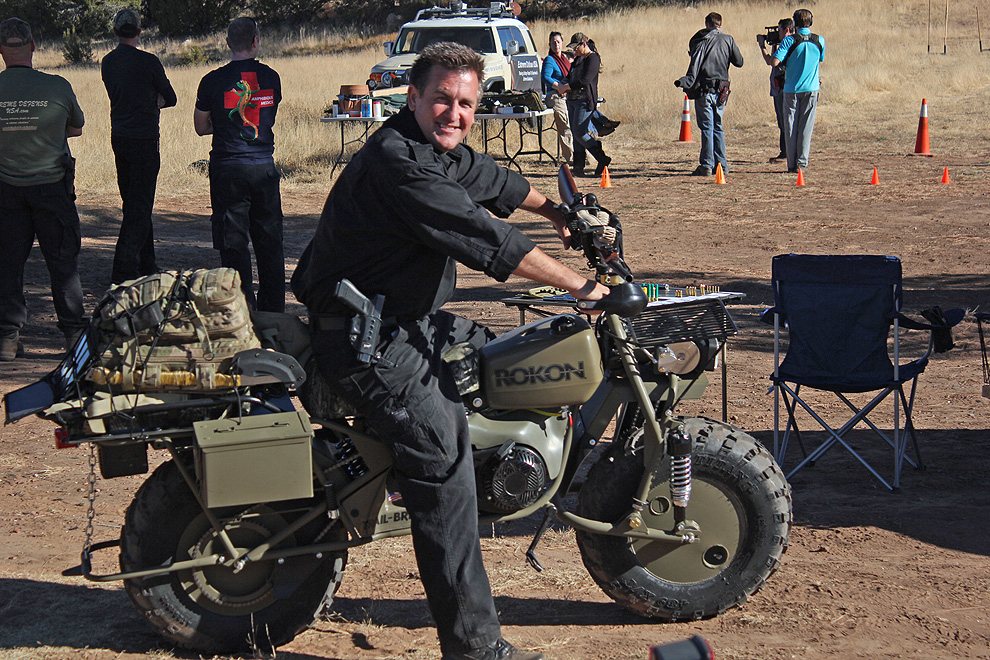
Four months after I first met Ralston, I’m on the way to his office in Scottsdale, Arizona, to see what, exactly, the Crovel had wrought. As I drive past the cacti and strip malls, Ellie Goulding’s "Anything Could Happen" comes on the radio: “That was the year / I knew the panic was over,” Goulding trills over a simple beat. “Yes since we found out / Since we found out / That anything could happen / Anything could happen / Anything could happen / Anything could happen / Anything could happen / Anything could happen / Anything could…” and the music explodes into a synth-bass siren.
Aside from the Crovel itself, Ralston’s great stroke of genius was recognizing that Americans were getting more and more nervous about the end. It didn’t matter which end the nerves were about — the end of the world, the end of capitalism, the end of upward mobility, the end of cheap gas — things were changing in America. It started with 9/11, when Americans were reminded that hegemony does not guarantee invulnerability. Since then, Hurricane Katrina, Hurricane Sandy, Hurricane Isaac, 2008’s financial crisis, the debt ceiling, the fiscal cliff, and a host of other holy-shit events have only reinforced the reminder that the United States is not immune to systemic hardship. Sometimes the worst really does happen; sometimes the status quo can’t hold. One prepper I met at the convention was wearing a Livestrong-like plastic bracelet around his arm. Its inspirational message? “Step out of the normalcy bias.”
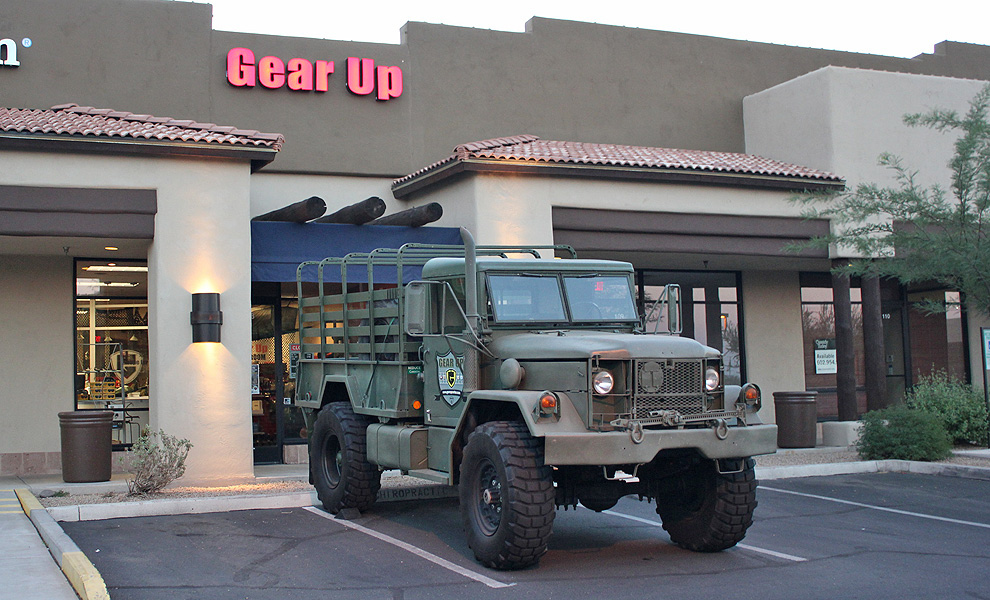
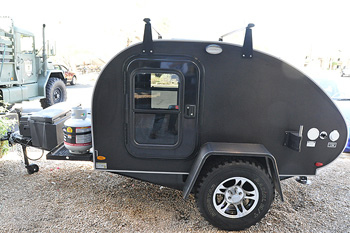
Ralston calls his store the Gear Up Center, and as I pull up, I see one of Ralston’s newest pieces of gear, the Bug Out Survival Shelter (B.O.S.S.), outside the shop. It’s a trailer you tote behind your truck when you’re Bugging Out, aka Getting Out of Dodge, aka G.O.O.D. Once you’re out, you can sleep in the trailer’s padded floor, cook on its full stovetop, and eat from the six months’ worth of food and water it’s able to hold. Retail: $20,000. Ralston’s signature comes as part of the paint job.
The shop is an emporium. It has everything from night-vision binoculars ($850.99) to a spork ($5.99). Advanced clotting sponges ($38.99), portable toilets ($19.99), and survival cave food ($139.99) line the walls. (You’ll soon be able to buy the latter with Ralston’s face on it.) And of course, there are the Crovels. Nearly a dozen models are strewn across the showroom, demonstrating its full evolution from spade to slayer. A tree stump rests on the floor so you can give the Crovel’s axe blade a try. The stump is surrounded by splinters.
Ralston’s in the back, where he shares an office with three other employees. There’s an iMac on Ralston’s desk, a map tacked to the divider wall, and a blindfold in Ralston’s mailbox. Beside him is his wife, Marie, a Michigan transplant who has been slow to come around to the prepper mentality. But Ralston and Marie do most of their business ventures together, and so she came along for this too.
When I walk in, he is looking at another new product he’s launching: a hybrid bomb shelter/country cabin. Bomb shelters are common in the prepper industry, but Ralston wants to combine a typical shelter, which you bury underground, with a fully functional prefab domicile up top. This way it’s a practical investment even before T.E.O.T.W.A.W.K.I. “Last thing my family's going to want to do if nothing happens is say, ‘Let’s go up to the mountains and dive in a hole.’ But if I have a beautiful cabin above, let’s just go to the cabin. It's nice, it's cozy, but if something bad happens, now you've got that fallback. That combination made sense to me.” Ralston partnered with shelter and cabin companies Survive-a-Storm and Pinnacle Park Homes to make it happen. All Ralston has to do is furnish it with survival gear and brand it with his visage. Retail: $99,000 for the base model. A skirt to hide the shelter's underground air vents is included in the package. The product as a whole will likely be called the Tim Ralston Survival Retreat.
“Branding-wise, it's not going to be Gear Up,” he says. “Gear Up is just the storefront. I look at, when we're marketing it, it's easier to make me the product than it would be the product itself. Because then I can become the iconic figure in survival,” he told me. Ralston wants to be like Bear Grylls — an embodiment of authenticity and quality.
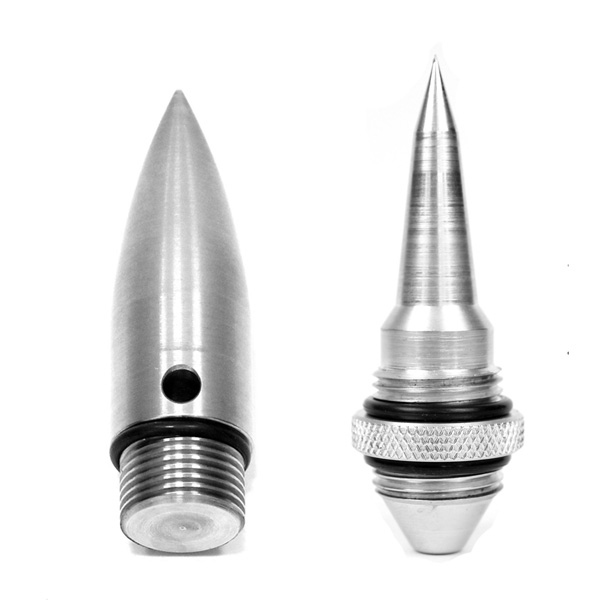
Among a certain crowd, Ralston has already ascended to that higher plane. Zombie obsessives go gaga over the Crovel. Above Ralston’s desk is an illustration, made by a fan, of a guy using a Crovel to splay a zombie’s skull. Two months after the device was released, Ralston started selling screw-on accessories to replace the crowbar, turning the butt end of the tool into another weapon. He sells a Crovel Attack Pack ($80.50), which comes with a sharper Crovel head and two spikes to screw onto the end — the Super Spike and the Z Spike. (Z is for, well, you know.) There’s also the Z-Sling ($35.95), which turns the Crovel into a projectile weapon.
Zombie prepperism is a sub-subculture, a quirk inside of a quirk, but is in many ways more mainstream than prepperism itself. For the last half-decade, the zombie apocalypse has become an enormously profitable fantasy. Depending on whom you talk to, the zombie apocalypse is either really about zombies, or just something that turns everyone around you into desperate, selfish humans. When I was at the prepper convention earlier in the year, someone from Z.E.R.T. (Zombie Eradication Response Team), a collective of former soldiers who do survival training, told me that “zombie” is really just a palatable metaphor for some guy trying to take your stuff. The Department of Homeland Security even had a zombie apocalypse drill.
“It's a true fear of some kind of biological weapon being unleashed and then turning people that are living into the walking dead,” Ralston says. “Zombies are the ones infected by some kind of biological chemical, where they’re not thinking.”
When Ralston created the Crovel, he saw the craze for what it was: a pop phenomenon that wasn’t going away. So he started to market the Crovel as a zombie defense weapon. “My wife didn't understand it. I said, ‘Trust me, it's huge, it's gonna get bigger.’” When zombie YouTube shows — they are legion — came calling, Crovel sent them sample units so they could show hot Crovel-on-zombie action. They were only too happy to oblige.
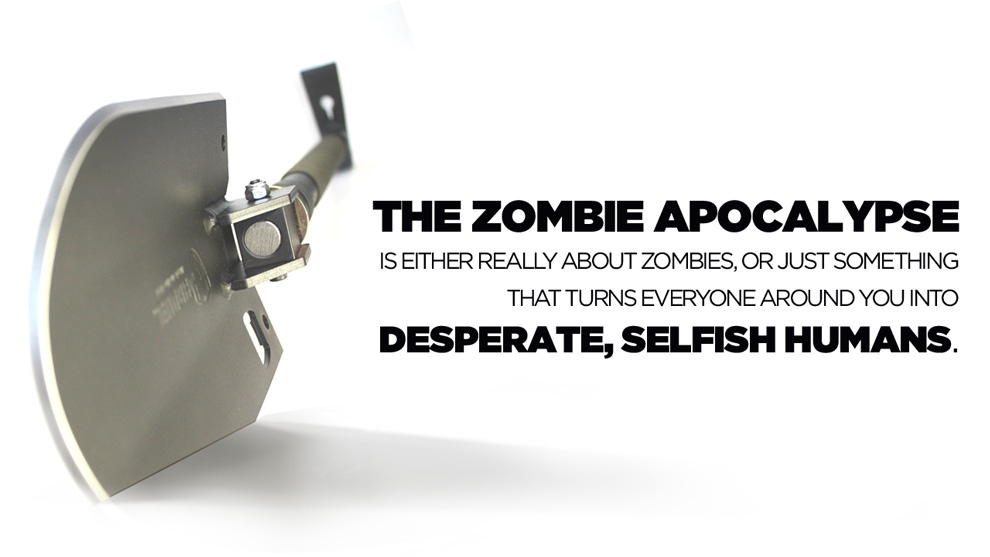
To a salesman, anxiety is opportunity. And Ralston’s been a salesman since he was a kid. Growing up in Colorado Springs with his lupus-stricken father, he would head out to trade horses with his dad. “I could swap the best of it with any of those guys. Before you know it, I’d be, ‘I need that saddle over there too, thrown in. Do you want me to take that nag off your hands?’ And this is coming out of an 8- to 10-year-old. So the old-timer, after he got done laughing his ass off, he still threw in the saddle.”
It was because of his dad that Ralston says he first became a prepper. One day, while he and his father were out riding, he saw his dad help a woman who fell off her horse. “We were horseback riding and a tragic accident happened, and he was there with the skills, the calmness, the ability to direct — saved the person’s life. At that point I’m like, well, How do I become that guy? I have to learn.”
Yet, until a couple years ago, he wasn’t really that guy. “My wife was very content in her normalcy bias of not believing anything would ever happen to us or anybody in the country, and everything hunky-dory, and we should be keeping up with the Joneses, and we had a 6,500-square-foot house. It was all just, ‘Where's our next client, where's our next meal? Let's get bigger, richer, bigger, richer, bigger, richer, bigger, richer.’ I was always on that watchful eye of, ‘We need to get stuff.’” (At the time he was running his marketing company, E Image Agency, with his wife.)
Hardcore preppers are nothing without their stuff. Money, after all, won’t be worth much once The Shit Hits The Fan (T.S.H.T.F. in preppernacular), so a prepper might as well spend it all on gear now. Dried food, bomb shelters, water purifiers, first-aid kits, weapons — they’re all worth more after the fall than before.
But until recently, Ralston didn’t have the material goods to prove his bona fides. “I'd squirrel away a little money here and there, and I would buy things as I could. But [Marie] would never let me go buy a gun,” Ralston says. “She'd spend $5,000 on a patio set. But I couldn't go buy an $800 gun without having a freaking tit for tat,” he says. (Ralston loves to number-drop. Nearly every story he tells comes with a stat or dollar amount embedded somewhere within. Take them with a Crovel-ful of salt.)
After high school he followed in his father’s footsteps and joined the military, becoming a senior airman in the Air Force. But for Ralston, there wasn’t enough capitalism in federal employment. “There's no reward for doing a good job,” Ralston says. “That was the reason I left. And because they kept telling me to cut my hair.”
For the next two decades, Ralston went through a dizzying series of jobs and careers, constantly remaking himself to fit whatever opportunity arose. His résumé: ski instructor, fashion model, fashion photographer, gym-membership salesman, co-inventor of a cosmetic-pencil sharpener, QVC pitchman, tanning-salon owner, and speculator in Nigerian gold.
The latter was the first time Ralston used right-wing culture to help turn a profit. In 2010, Ralston and his wife realized that the gold business — which is to say, the business of buying gold jewelry, melting it down, and selling it to hoarders — was proving hugely profitable. In the wake of the financial crisis and traditional economies faltering, investors thought a tangible asset like gold was one of the only safe places to park large amounts of cash.
After a failed attempt at trying to get people to donate their gold to their favorite charities (Ralston would take a cut, the nonprofits would get the rest), Ralston happened upon a guy who said there was plenty of gold in Nigeria. “So we go, ‘Let's go to Africa.’ Ho ho ho. That was interesting. To say the least.”
Ralston would buy out local advertising on Nigerian radio stations and in local newspapers. He’d show up at a given place, set up shop, and wait. People would bring in the gold, Ralston would weigh it, “scratch-test it and do an acid test,” then front the money to buy it. “I'd have one lady come in, put in front of me about 500 ounces of gold that’s old ancient stuff from her tribe that’s handed down, handed down, handed down.”
With each trip, Ralston says he took home more gold: $50,000 at first, up to $150,000 by the last trip. “I was the mule, baby. That is the most corrupt country in the world. You just have to bribe your way through it.”
Then came the Crovel. It started as an accident in 2010, when the shaft of Ralston’s father’s shovel snapped in half as he was packing it. Ralston had a neighbor weld a crowbar onto the shovel head and realized he was onto something. He went out and bought 30 more crowbars and shovels, welded them together himself, and brought them to a gun show. He sold out in 45 minutes. He brought a new batch to a different show. Same response. “I knew I had a product when I had guys at the end of the show coming over and trading me guns for shovels.”
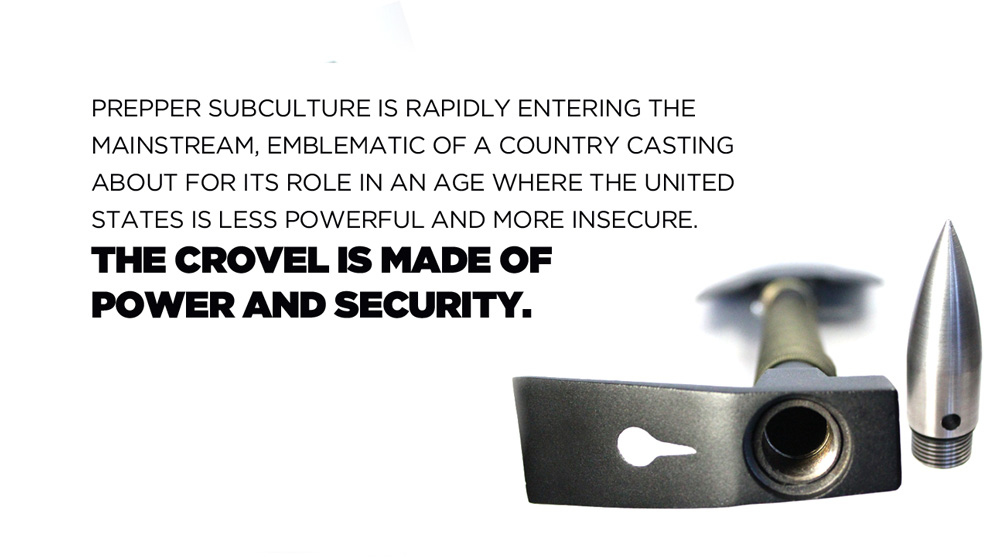
Back at the office, Ralston is on the phone. “Hey, Phil, this is Tim calling. Hopefully you’re not bleeding and dead from your bicycle ride.”
Phil’s late. He was supposed to come and talk to Ralston about yet another new product, a small dog tag for kids that comes complete with razor-sharp arrows laser-cut into it. In an emergency, you can pop them out to use for hunting. Ralston’s teenage son designed the tag; he isn’t a prepper, he just wants to get rich. “He sees what kind of money we're making,” says Ralston, “so he's going, ‘Hmmm. I like this. When do I get my Ferrari?’”
Phil, who knows Ralston because their kids play soccer together, is taking the dog tags, called E-TAG ($16.95), to a meeting with a Walmart buyer later in the week.
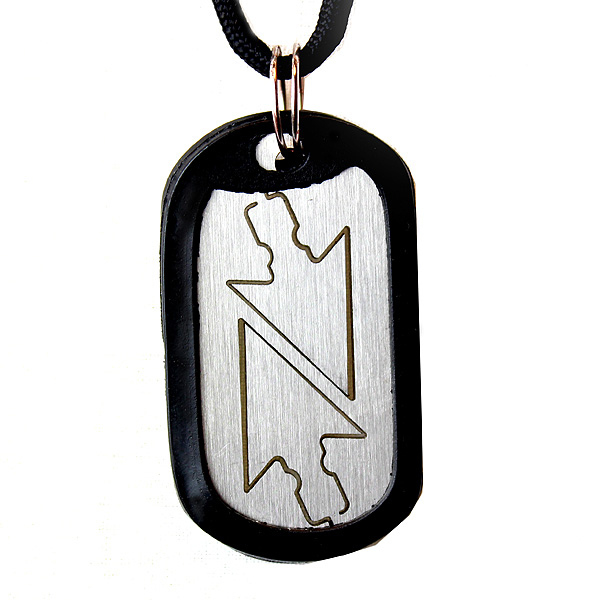
Ralston can’t help but give Phil some advice about how to pitch the product. “I personally would just name-drop. Say that I'm developing it with my son,” he says. “I'll email you my sizzle reel.” The product is only a week old, and Ralston already knows what he wants the packaging to look like. “The photo shoot will incorporate my face, which is more recognizable than [my son’s] right now, but I’m mentoring him.”
Phil is impressed, but he wants to make sure the packaging is as clear as possible about how to use the E-TAGS.
Ralston: “I get that on an impulse buy like this, the pictures have to be really compelling. They have to tell the story and it'll be one, two, and three, and that's it.”
Phil: “You’re talking 15 seconds max.”
Ralston: “Three seconds. I'd die if I had 16 seconds.”
Ralston and I decide to go camping. As we set out for the two-hour drive into the mountains, he tells me how he had visualized his ideal future. Ralston is an acolyte of The Secret, the inspirational book that has sold millions with Oprah’s help. He credits its teachings for all of his success. When he wants something, he visualizes it, memorizes it, and then waits for an opportunity to transform those good vibes into tangible achievements.
Of course, Ralston not only visualizes business success, he has turned the idea of visualizing success into a business. Before Gear Up, he and Marie launched Visionboardsite.com in 2008, which lets you create and manage your own vision boards to outline your goals and make them come true. (It’s like a motivational Pinterest.)
For $5 per month, Ralston would let users access thousands of pictures (of cars, women, other aspirational objects) to assemble onto the board. “For one minute you watch your personal vision board. It imprints into your subconscious and you'd be amazed how fast you achieve whatever you want,“ he says. Ralston’s visualization successes include the time he got a job as a ski instructor without knowing how to ski, the time he learned to become a helicopter pilot for free, and the time he stumbled into partial ownership of two yachts that look almost exactly like the ones on his vision board.
“Everything that I've gotten here is done off of my vision board,” Ralston says. Gear Up, a company that helps people prepare for a bleak future, is built on a foundation of optimistic thinking. “Everything I ever wanted to do, I’ve accomplished. I never look at anything I do as failure. Failure is so negative, number one. I learn more from not succeeding than I do from succeeding every time on first shot. I just never give up. That's the deal. If I can't get this way, I go that way.”
A couple hours later, Ralston tells me it’s time to put on a blindfold. I pull over, walk past the shotgun in the trunk, put my cellphone in a lead-lined bag so it won’t get service, and slip the fabric over my eyes. It is time for the final ascent to his mountain redoubt, where we’ll stop before heading into the woods. Ralston takes the wheel.
Preppers, unsurprisingly, can be privacy freaks. To know where a prepper lives, what gear a prepper has, how a prepper plans to escape when T.S.H.T.F. is to know how to take advantage of the prepper when disaster strikes. Ralston has his family to worry about; he can’t have you showing up at his hideaway and asking for charity. There’s only so much dried food to go around. Keeping the location private is, in a way, just another preparation for T.E.O.T.W.A.W.K.I.
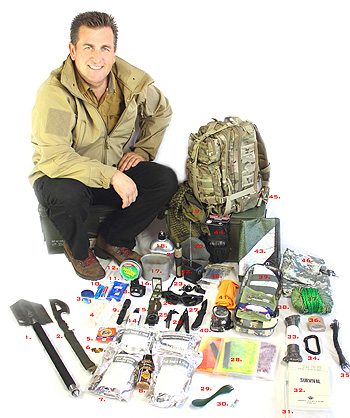
Ralston’s cabin is as you’d expect — a multilevel home with a national forest in its backyard and a 17-foot hole for a bomb shelter in its front, still being installed. The shelter is 45 feet long, 9.5 feet high, and looks like a shipping container (because it is). When we arrive, Ralston goes to take a look at its progress.
Because Ralston just got the cabin five months ago, there was only one room in the house that had a bed. (Before that, his hideout was in a place closer to Scottsdale; he felt like he had to move because of the Doomsday Preppers attention.) Other than that and the massive backup electrical batteries downstairs, it’s a house like any other. A grand piano sits in the living room. Do-it-yourself encyclopedias line the bookshelves beside a 1992 issue of Foreign Affairs, the Hebrew Tanakh, and Walter Isaacson’s Einstein biography.
“Come on, you bastard.” Ralston says through gritted teeth as he packs in the living room. He is struggling with his Bug Out Bag, an estimated 55-pound beast that he was going to lug into the forest. He sells a version for $909.50, complete with a Crovel and 44 other items, including a ShamWow.
He mounts his pack. I do the same. He has the Crovel. I have the beer.
It’s just past dusk when we start hiking. “If you're scared of the dark, it's a good gut check,” he says. “Are you scared of the dark?” I ask. Ralston: “No. Just what's in it.” Earlier, he had warned me rangers had to shoot several bears nearby after a series of attacks. A shotgun rests on his hip.
After about 15 minutes, we get to the campsite. A fire pit is in the center with a few tree stumps around it. Ralston has built a lean-to between two trees to keep his hammock away from the wind. He comes here enough to justify the investment. A month after I leave, film crews from Switzerland and Bulgaria are due to arrive. He will blindfold them too.
I asked if Ralston wants this to be his everyday life, roughing it in the bright air of the mountains. “Oh, hell no,” he says. “But practice makes perfect. The more often you can do it, the less you fear.” Earlier he had asked if I wanted to skip out on the camping, go have a meal in town, and spend the night in the cabin. I declined.
At camp, he turns on his solar-charged LED flashlight ($380) and gets to work. He gets the Crovel lodged in a log after a few tries. “If anything comes into camp, grab that and start wailing on it,” he says.
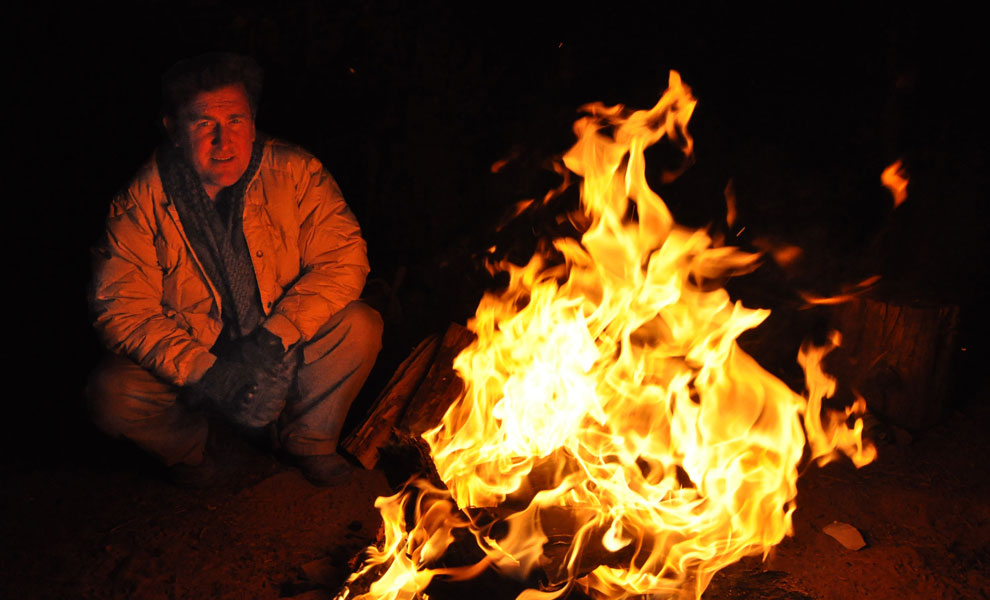
He gets the fire started with a tampon — “lights quickly”— and we string up our beds for the evening. Both of us are going to sleep in hammocks, mine enclosed ($62.49), his not. He breaks a dead limb into a wide log and put it down for later. It will be his pillow.
We boil some water, mix some dried chicken concoction into it, and dinner is served. There are some carrots, green beans, onion, and undercooked potatoes floating in the broth. It tastes like a salt lick. It’s not so bad.
Ralston prepares camp toddies — shots of whiskey in some type of powdered mocha drink. “There’s survivin’ and then there’s survivin’,” he says. We each down a few beers and a lot of mocha. After three hours of amicable chat about Hurricane Sandy, New York City gun-control laws, and Ralston’s idea for a reality show he’d host (a sort of Extreme Makeover: Prepper Edition), we go to sleep. The Crovel hasn’t been touched except to pop the tops off the Coronas.
It’s hard to tell time when my phone is sealed in a lead pouch a half mile away and I haven’t brought a watch, but I wake up what I believe to be a few hours later. It’s cold, it’s windy, and there’s something rooting around in the campsite.
It’s Ralston. He’s concerned about the fire with the winds blowing so hard — they had to be 20–30 miles per hour at least. Arizona has already lost over 1.2 million acres of forest to wildfire in the past two years. The fire is an emergency, however small.
He empties the last of our water onto the fire, gets the Crovel, shovels dirt on it, and stamps out the scattered embers. I get up to pee (whiskey + beer + chicken soup = sleepless night) and start walking into a clearing. Piss on the fire, Ralston says. I turn around and do as I’m told.
Some time later, I’m awake again. The wind is gone, but it’s still dark. Is that snow on the ground? No. Just frost. Is that Ralston rooting around again? Yes. Just like before. But this time he isn’t putting the fire out. He’s trying to get it started. He’s standing over the pit, trying to stoke whatever embers haven’t been soaked through. Ralston gets down on his knees. He cocks his head to the side and blows. A little light glows. Not much, though — it doesn’t look promising.
Ralston sucks in. He blows out. Heee, hoooooo. Heee, hoooooo. Over and over. He won’t stop, though there’s still nothing that suggests he can make it happen.
But Ralston sees something I don’t. He roots into the fire and picks up a square, charred log in his hand. He cradles it in his Kevlar gloves. He blows on it. He tosses it back and forth in his hands. It lights. He sets it back down in the fire and blows on the whole pit again. It crackles to life. He had gotten what he wanted. He had made it happen.
Meanwhile, dawn has broken.
After target practice, we break camp and hike out, and I put my blindfold back on. Ralston wants to take me to a little mountain diner in town, maybe a five-minute drive from his cabin.
He orders a Denver omelet, a pancake the size of his face, and a cup of coffee. The mug comes with the town’s name stenciled on it. On the back wall, there’s a map of the surrounding area, with the town names in big letters. One of them matches the mug. The location of Ralston’s hideaway has been revealed (but, out of decency, will not be published). The universe has brought it to me.
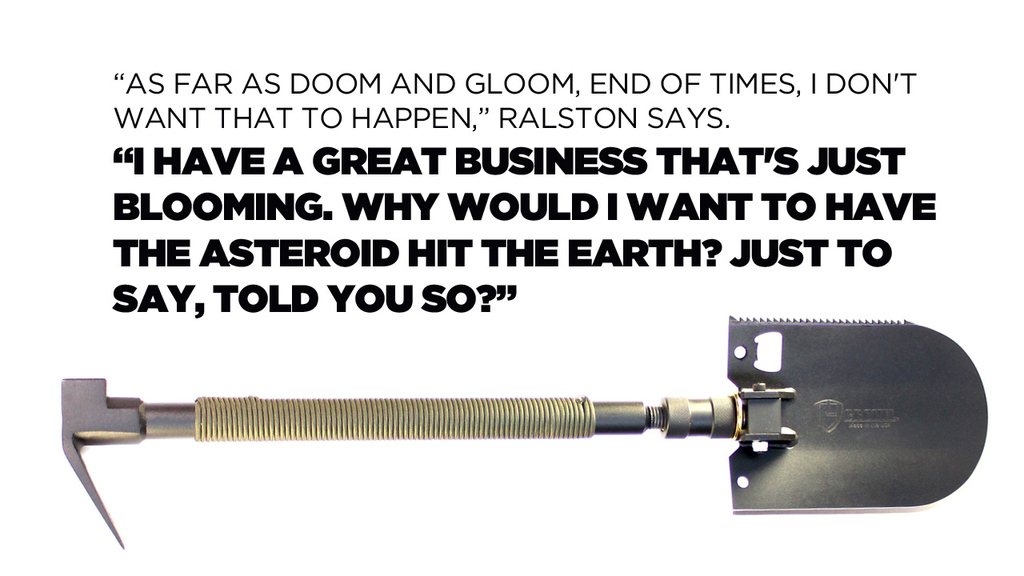
Back at the office, Ralston’s staff is busy getting holiday orders out the door. There are hundreds of Crovels in stock, and they have to get shipped by Dec. 10 to make it in time for Christmas. There isn’t a distribution center. Crovels come from the factory to Gear Up, and then from Gear Up to you. “He’s usually in the back, tinkering with new ideas,” Marie tells me about Tim. “We’re the ones taking care of all the stuff.”
I ask how this holiday season compared with last year's in sales. I’m reminded that there wasn’t a last season — the Crovel, for all intents and purposes, made its debut when Ralston did. That Doomsday Preppers episode didn’t air until Valentine’s Day 2012. Ralston’s empire is still fledgling.
Ralston and I have only one more stop to make: I want to see one of his manufacturing plants nearby. Since the beginning, Ralston has had trouble keeping up with demand for the Crovel. As the business has grown, so have Ralston’s needs.
To get to the factory, we take the Deuce, a 2.5-ton retired military transport vehicle that Ralston bought on eBay (he hopes to sell it for $19,250; email him if interested). Its speedometer maxes out at 55 miles per hour, at which point the RPM arrow shakes wildly in a zone labeled “Danger.” The gear shift is 18 inches tall, the roof pops out so you can shoot out the top, and it’s so loud, Ralston and I can’t really converse during the 20-minute ride. This is the male id on four wheels. Ralston tells me sometimes he gets flashed while driving it.
At the factory, proprietor Rob Howell gives us a tour, telling me that he’d love to make more Crovels, if only he had the machinery. Seeing all those bits and pieces scattered about with all the other work Howell’s team is doing makes me wonder: Besides a piece of 4140 hardened chromoly, what is the Crovel, really? There are plenty of shovels, plenty of axes, plenty of inventions in the world. What is it about the Crovel that is so marketable?
I am standing inside part of the answer. The Crovel’s marketing signifies two things that a major chunk of the country perceives America has lost: self-reliance and domestic production. Obama’s presidency has acknowledged that the U.S. isn’t alone in the world — and that the only way to get by in a globalized economy is to cooperate and compromise. It’s the complications of modern society that make us dependent on one another. The Crovel, with its website’s big, bold “MADE IN THE USA,” is a bulwark against that; it’s a suggestion that things can be the way they were. All you have to do is prepare for the way things might be.
Likewise, Ralston is almost antiquated in his salesmanship. He has an unwavering confidence in capitalism and an unwavering confidence in the self — two things that have been in short supply for America. He has turned the American Nightmare into the American Dream.
“As far as doom and gloom, end of times, I don't want that to happen,” he told me on the car ride up to the cabin. “I have a great business that's just blooming. Why would I want to have the asteroid hit the earth? Just to say, told you so? That’s not what I want at all."
By the time we get back to the office, I’d spent nearly 28 hours straight with Ralston. It’s time to go. I wander through the office saying my good-byes. “I’m going to go to the restroom and leave you guys to...”
But before I could finish the sentence, Ralston does it for me: “Make millions!”
